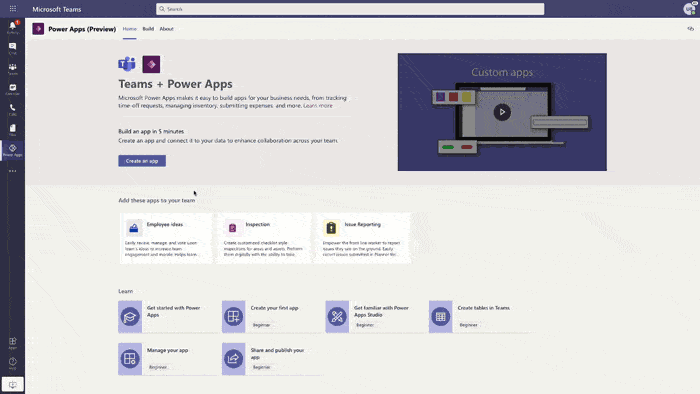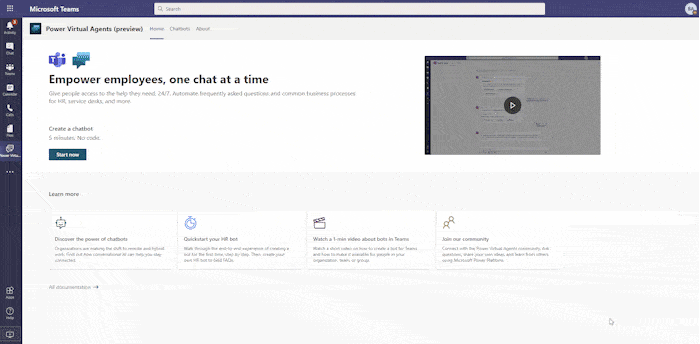
Knowledge base
November 28, 2020
Reshape the future of work with Microsoft Dataverse for Teams – now widely available.
Common Data Service, the advanced and secure backbone that drives Dynamics 365 and Power Platform, has been renamed Microsoft Dataverse. This low-code data platform is rapidly changing the way organizations around the world build apps and innovate business processes. A new name is just part of a broader effort to introduce the power of what Dataverse can do for individuals and organizations around the world.
Another key part of that strategy is Microsoft Dataverse for Teams – the essential subset of Dataverse capabilities that is included as a powerful, built-in data platform for millions of Teams users at no extra cost. We’re pleased to announce that Dataverse for Teams is now widely available, along with a range of built-in Microsoft Power Platform tools that allow customers to easily build low-code apps, automate processes, and deploy chatbots without leaving Teams.
Since these embedded capabilities came to preview in September, we’ve seen more than double the number of organizations that Use Power Platform in Teams to transform business processes in the digital workspace. Much of this expansion is driven by the accessibility of Dataverse for Teams as a low-code backend: customers have already trusted more than 20 terabytes of data in Dataverse for Teams in less than two months of preview alone.
These organizations enable their users to save time and solve their toughest challenges, all without leaving Microsoft Teams. T-Mobile, the second-largest wireless carrier in the U.S. with more than 98 million customers, is one of those companies that is transforming its business with Power Platform and Teams. Brian Hodel, a Senior Developer, explains how T-Mobile enables their employees to create their own solutions and solve business challenges:
Microsoft Dataverse for Teams together with Microsoft Power Platform is a game changer. This powerful combination empowers everyone to work together and solve business challenges that meet the needs of a swiftly changing work environment. Where there used to be no way to easily centralize processes, now everyone has a single source of truth with centralized data and is better positioned to solve business challenges by building apps and bots at scale and innovate more rapidly.” —Brian Hodel, Senior Developer, T-Mobile
Save time with Power Apps in Teams:

With the embedded Power Apps Studio in Teams, it’s now easier than ever to create, edit, and share low-code apps that connect to data from Dataverse or more than 400 other data sources. With native responsive layouts and fluid controls to deliver enhanced image and video experiences, Teams users can easily create advanced custom applications within the Teams app. Telstra, australia’s largest communications company, uses Teams and Power Platform to strengthen their field staff and drive innovation in their operations:
Microsoft is very excited about Microsoft Dataverse for Teams, which will provide our end users with a seamlessly integrated experience, along with access to scalable datasets, enterprise security features, and the ability for all team users to now become citizen developers and solve business issues from Teams. . “- Nathan Backers, Head of PowerFactory, Global Business Services
Infuse teamwork with insight using the Power BI app in Teams
Licensed Microsoft Power BI users can now take advantage of the full capabilities of Power BI in Teams with the Power BI Teams app. We’ve created a new experience that centralizes data, reporting, and insights from across the organization in a consumable, shareable way. Users can analyze and connect to usage in Dataverse for Teams, giving them seamless access to insights wherever users work and collaborate. Suffolk Professional Services, known for iconic projects such as the tallest residential tower in Boston and a guitar-shaped hotel in Florida, uses Microsoft Teams and Power BI together to quickly make better decisions and work together from the job site to headquarters:
We have some very smart engineers in our IT Collaboration team who looked at Microsoft Teams and saw a lot of potential there. We use Power Platform and Microsoft apps to create a whole host of task management tools for construction crews. “- Ajoy Bhattacharya, Senior Director of Innovation and New Technology, Suffolk Professional Services
Help for everyone with Microsoft Power Virtual Agents
Power Virtual Agents for Teams, along with the embedded authoring studio, is now widely available. Teams users can use seeded capabilities in the app so anyone can easily build, share, and use chatbots to scale support across organizations. Many organizations, including the City of Ottawa, use Power Virtual Agents and Teams to answer a wide range of employee questions:
In response to the global Covid-19 pandemic, our government organization had to quickly switch from an office-oriented role to a work from home. By using Teams and Power Virtual Agents, we were quickly able to deploy what we called “OBot”, a Power Virtual Agents-based internal bot for employees deployed through Teams that provides quick answers and how-tos for all homework-related issues. the support burden not only for the IT service desk, but also to support HR and other departments. “- Gary Belcourt, Solution Project Manager, City of Ottawa.
HR and FAQ bots that connect Power Virtual Agents to company data through Microsoft Dataverse for Teams save an organization time and money.

Optimize repetitive processes with Microsoft Power Automate
It’s also never been easier for customers to get started with Power Automate in Teams with a new home page in the new in Teams app. With a new Create experience in Teams, focused on templates, it’s easy to build new streams. The new API-M connector for Power Automate lets you integrate with existing systems, services, and data connected to Azure API Management Service. Whether you want to automatically schedule one-to-one calls or set approval streams, Power Automate and Teams can help you save time and focus on higher-value-added work.
Manage and secure low-code in Teams
Microsoft Dataverse for Teams respects Power Platform’s existing data governance paradigms and enables access control in the Teams Admin Center, just like any other Teams feature. The Power Platform admin center provides more detail, including monitoring specific capacity usage and DLP policies.
Microsoft Dataverse for Teams significantly simplifies the management of the environment’s lifecycle and user security role management by aligning with Teams constructions. Learn more about automated role management for Dataverse.
Customers can also use Governance workflows found in the Power Platform COE toolkit solution and customize them if necessary. Learn more about the management components of the COE toolkit.
Get started with ready-made templates

Microsoft sees incredible traction with the ready-made app templates like the “Ideas” app. This solution ensures that all team members have a platform to present and share ideas. Templates can be as-is used or easily customized with low-code Power Platform tools and implemented with one click. Customers immediately begin to see value by quickly implementing a framework for innovation and idea building. Learn more about Employee Ideas and other pre-created templates.
Source: microsoft
Want to know more?

Related
blogs
Tech Updates: Microsoft 365, Azure, Cybersecurity & AI – Weekly in Your Mailbox.








